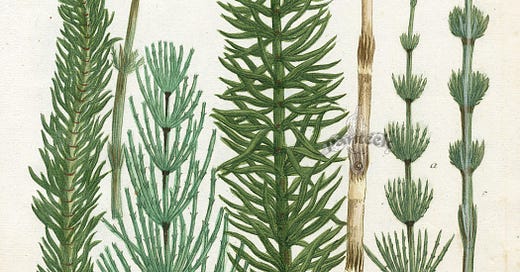by Hugh Williams
Rudolf Steiner indicated that horn manure could, if necessary, be made with horse manure by wrapping the cow horn with the mane of a horse. Could horsetail, the old name for equisetum, carry more than a mere morphological analog? I support Hugh Courtney’s finding that equisetum is transformed into the ninth preparation by, in addition to boiling, fermentation and homeopathic extension. These steps transform it from an herbal tea into an instrument of specific dynamic activity.
In Australia we used She-oak (Casuarina littoralis) for the same purpose. It is a tree up to 60 feet tall, and grows as a relic of ancient silica forests—one can well picture dinosaurs wading around and ripping huge masses of them down into sulfurous wallows to eat, together with all other manner of algal slime (somehow, this talk of water and slime calls to my imagination another preparation, BD 505, oak bark).
The Australian Aborigines believe that powerful creation spirits called Wandjina give the rain. The people’s Dreaming must nurture and watch over the spirits’ well-being. If this is not done, and conditions decline too far, art is used: the people are inspired to paint the Wandjina.
I don’t know what has happened to you, but all your spirit has gone out of you. No men or women watch over you, for the people who belong to this place—my aunties, sisters, fathers and grannies—they are all dead now. Only I, that belong to another place, came to visit you, but you were lonely for all those people who died and your spirit has gone away now.
Because you were looking all dull–you’re not looking bright–I’ll try and draw you. I’ll try and put new paint on you people . . .don’t get wild, don’t send rain! . . . You must be very glad that I’m going to make you new—don’t try and get wild and don’t send the rain to me . .. . I made you very good now—I don’t know how I did it.
Very good! . . .You must be very glad, because I made your eyes like new. That eye, you know, like this my eye . . . I made them new for you people. My eye has life, and your eye has life too, because I made it new . . .
Don’t try to bring rain, my wife might drown with rain. The rain might drown her.1
We read in Australian Dreaming–40,000 Years of Aboriginal History, that a most powerful Wandjina, Wodjin, “was able to bring heavy rain by stroking his beard.” This is a magnificent picture of the wind combing the She-oaks before a typical Australian deluge. Like many Australian plants, the She-oak is extremely tough and requires drastic measures to release its dynamic potency. In America, with equisetum, we have to get down on our hands and knees to get a similar picture. In ancient times these were also large silica trees. Still, the sporulating form, early in spring, gives an equally, if not more vivid picture of something ancient.
I must admit that my belief in the efficacy of BD 508 rested on faith until I began fermenting it and extending it homeopathically. At that point, I experienced BD 508.
Keep reading with a 7-day free trial
Subscribe to The Josephine Porter Institute - Applied Biodynamics to keep reading this post and get 7 days of free access to the full post archives.





